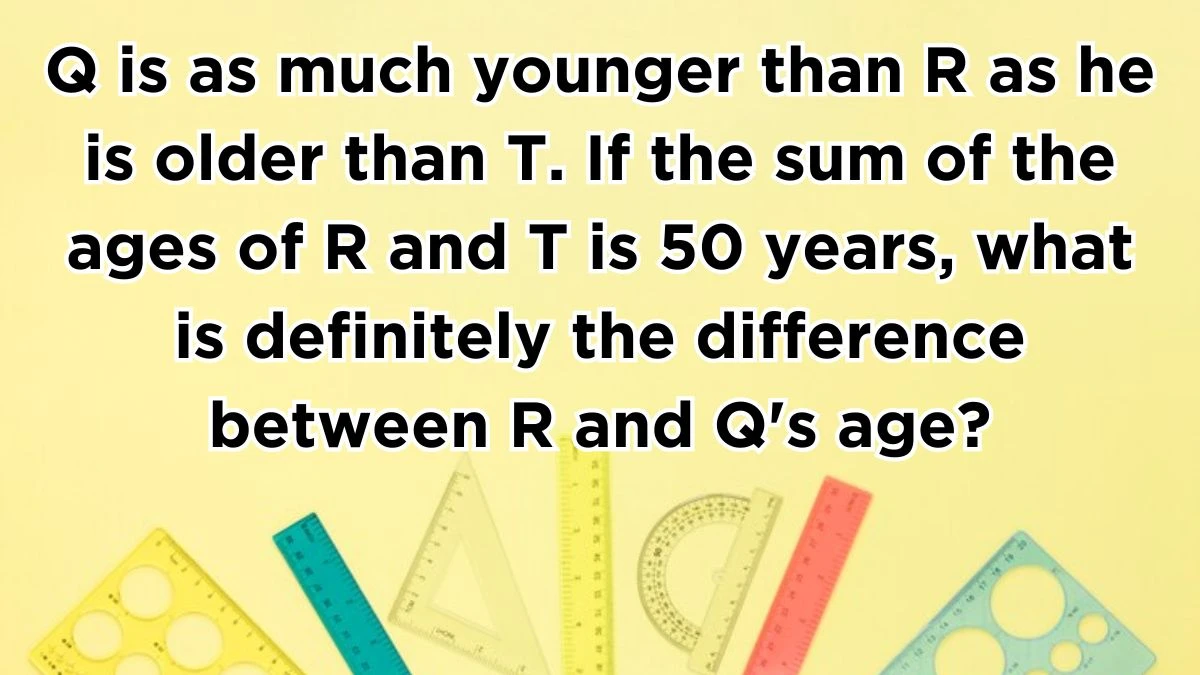Q is as much younger than R as he is older than T. If the sum of the ages of R and T is 50 years, what is definitely the difference between R and Q's age?
by
Updated Jun 10, 2024

Q is as much younger than R as he is older than T. If the sum of the ages of R and T is 50 years, what is definitely the difference between R and Q's age?
The problem states that Q is as much younger than R as he is older than T. Additionally, the sum of the ages of R and T is 50 years. We have to find the difference between the ages of R and Q. Choose the correct answer among the options given below.
A. Data inadequate
B. 25 years
C. 2 years
D. 1 year
Setting Up the Equations:
Given that Q is as much younger than R as he is older than T, we can express this as:
R − Q = Q − T
This equation tells us that the difference between R and Q's ages is equal to the difference between Q and T's ages.
Sum of Ages:
We are also given that the sum of R and T's ages is 50:
R + T = 50
Express Q in Terms of R and T:
From the equation R − Q = Q − T we can solve for Q:
R + T = 2Q
Q = (R+T)/2
Substitute the Sum of Ages:
Since R + T = 50
Q = 50/2 = 25
Determine the Difference R−Q:
We have to find R−Q
Q=25, but we do not have sufficient information to determine R's age
Thus, we cannot determine the exact difference between R and Q's ages without knowing R's age. Therefore, we can choose option A.
Age-Related Problems
Age-related problems are common in algebra and are designed to test logical reasoning and the ability to set up and solve equations. These problems typically involve relationships between the ages of different people at different points in time.
Understanding Relationships:
- Age problems often involve understanding how the ages of different individuals relate to each other.
- This may include knowing how much older or younger one person is compared to another.
Setting Up Equations:
- The primary step in solving age problems is to translate the given information into mathematical equations.
- These equations represent the relationships between the ages of the individuals involved.
Using Variables:
- Assign variables to unknown ages to create equations that can be solved.
- Commonly, we use letters like x and y to represent the ages of different people.
Sum and Difference of Ages:
- Many problems involve the sum or difference of ages.
- Understanding how to manipulate these sums and differences is crucial for setting up the correct equations.
Solving the Equations:
- Once the equations are set up, use algebraic methods to solve for the unknown variables.
- This may involve techniques like substitution, elimination, or factoring.
Steps to Solve Age Related Problems
- Understand the given information and identify what is being asked.
- Pay attention to keywords that indicate relationships, such as "older," "younger," "sum," and "difference."
- Choose variables to represent the unknown ages.
- Write down what each variable stands for clearly.
- Based on the relationships described in the problem, set up equations.
- Ensure that the equations accurately represent the given information.
- Use appropriate algebraic methods to solve for the variables.
- Check the solutions to ensure they make sense in the context of the problem.
- Substitute the values back into the original equations to verify they satisfy all conditions.




